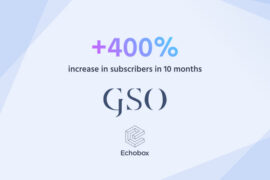Ever since Echobox was founded, we always ask ourselves how we can best use our expertise in data science and machine learning to serve the journalism industry, an industry we deeply care about.
Since we started in 2013, we’ve created the world’s first social media publishing solution designed specifically for publishers and added unique and bespoke functionalities to meet the ever-evolving needs of our clients. Today, over 1000 of the world’s leading publishers use Echobox Social to manage, optimize and automate social posts to billions of followers on Facebook, Twitter, TikTok, Instagram and LinkedIn.
We believe that intelligent social media automation is one answer, but there are many more.
Between 2013 and today, publishing has evolved to follow and exploit trends in content consumption. When we consulted with publishers about their challenges and priorities, one topic in particular was brought up again and again: newsletters. In the last few years, as digital subscriptions have grown from a supplementary revenue stream for most publishers to, in some cases, a viable alternative to advertising, the number of newsletters has multiplied, and for good reason.
Newsletters have two distinct advantages over other means of content distribution:
- Unlike sharing content over social media or via news aggregators, with newsletters there is no intermediary between publishers and their audience. When publishers are not beholden to a platform’s secretive algorithms (algorithms that they have no control over, and whose workings remain shadowy and opaque) they have full control over what their audience sees, and when. We know, for example, that Facebook penalizes publishers for certain actions such as sharing too much or too little, too frequently or infrequently. We know that these rules are always subject to change depending on the exact configuration of Facebook’s algorithms and which behaviors or content it chooses to prioritize at any given moment.
By providing content directly to your audience’s inbox, you don’t have to worry about third-party platform algorithms, and your content can be far more targeted. Now, instead of trying to maximize engagement with an audience of millions with diverse interests, you can optimize your content for smaller segments of your audience, each of whom were interested enough in a topic to sign up.
- The corollary of this greater specificity is that the data that can be gathered and analyzed is far more abundant and granular, creating a virtuous cycle: the more detailed the analysis of your audience’s behavior, the more targeted your newsletters can become and the more detail your insights will reveal.
This is vital when considering a publisher’s marketing funnel. Publishers around the world are seeing enormous paid subscription boosts facilitated by newsletters because they can turn non-paying, new visitors into loyal readers, who can later convert into paid subscribers. Indeed, habit formation is perhaps the single most important part of converting casual readers to subscribers. By repeatedly getting your content in front of curious readers on a regular basis, your newsletter can become a welcome part of everyday life. As the New York Times’ Editorial Director of Newsletters Adam Pasick notes, “Newsletters are a great way to grow a subscription business. Subscribing to a newsletter is a healthy habit that can bear fruits down the line.”
By ensuring that content is as relevant as possible to their specific audience and delivered regularly in the best possible format and at the best possible time, publishers can demonstrate the necessity of their content and convert the curious into the committed.
It’s clear that newsletters are a potent tool for communicating directly with your target audience and building a lasting relationship with them.
But getting the greatest possible return from newsletters is a complicated and time consuming business, requiring educated guesswork, mountains of testing and many, many different iterations. In conversation with our clients, a recurring set of frustrations emerged:
- Creating and optimizing newsletters is time and labor intensive.
- The workflow of managing newsletters is needlessly complex.
- Deciding which stories to include in a newsletter and picking the right send times in order to increase performance requires extensive data science resources, which many publishers don’t have access to.
These difficulties will be familiar to many publishers who, until now, have had to work within the constraints of newsletter solutions that simply weren’t built for them.
That’s why we’re excited to announce the launch of Echobox Email, the world’s first automated newsletter software conceived and developed explicitly for publishers.
Using a complex multi-algorithm approach, Echobox predicts which stories will most likely appeal to your audience and in which order. But most importantly, it keeps on learning. Every time your newsletter is sent, Echobox analyzes your audience’s response and adjusts itself accordingly. The more emails Echobox sends, the more it gets to know about what your audience likes, which order of stories can maximize engagement, which layout appeals the most and at what time your desired audience is most likely to read your stories.
Through a series of specific, data-led alterations, Echobox can optimize the performance of your newsletters whilst producing incredible time savings. In just 10 seconds, Echobox will generate the perfect newsletter, with fully optimized content, ordering and layout targeted specifically to your audience; all you have to do is press “send”. Simple as that.
Request a demo
Discover how AI can take your newsletters to the next level:




